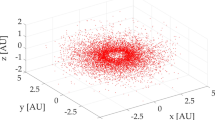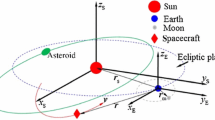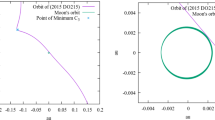Abstract
Technique of target selection and profiles of transfer trajectory for Chinese asteroid exploring mission are studied systemically. A complete set of approaches to selecting mission targets and designing the transfer trajectory is proposed. First, when selecting a target for mission, some factors regarded as the scientific motivations are discussed. Then, when analyzing the accessibility of targets, instead of the classical strategy, the multiple gravity-assist strategy is provided. The suitable and possible targets, taking into account scientific value and technically feasible, are obtained via selection and estimation. When designing the transfer trajectory for exploring asteroid mission, an approach to selecting gravity-assist celestial body is proposed. Finally, according to the mission constraints, the trajectory profile with 2-years ΔV-EGA for exploring asteroid is presented. Through analyzing the trajectory profile, unexpected result that the trajectory would pass by two main-belts asteroids is found. So, the original proposal is extended to the multiple flybys mission. It adds the scientific return for asteroid mission.
Similar content being viewed by others
References
Hulkower N D, Lau C O, Bender D F. Optimum two-impulse transfer for preliminary interplanetary trajectory design. J Guid Control Dyn, 1984, 7: 458–461
Lau C O, Hulkower N D. Accessibility of Near-Earth asteroids. J Guid Control Dyn, 1987, 10: 225–232
Perozzi E, Rossi A, Valsecchi G B. Basic targeting strategies for rendezvous and flyby missions to the Near-Earth asteroids. Planet Space Sci, 2001, 49: 3–22
Binzel R P, Perozzi E, Rivkin A S, et al. Dynamical and compositional assessment of Near-Earth object mission targets. Meteoritics Planet Sci, 2004, 39: 351–366
Qiao D, Cui H T, Cui P Y. Evaluating accessibility of Near-Earth asteroids via Earth gravity assists. J Guid, Control Dyn, 2006, 29: 502–505
Qiao D, Cui H T, Cui P Y. Design and analyze optimum two-impulse transfer trajectory for exploring asteroids (in Chinese). J Astronaut, 2005, 26: 362–367
Longuski J M, Williams S N. Automated design of gravity-assist trajectories to Mars and the outer planets. Celes Mech Dyn Astron, 1991, 52: 207–220
Bonfiglio E P, Longuski J M. Automated design of aerogravity-assist trajectories. J Spac Rock, 2000, 37: 768–775
Sims J A, Longuski J M, Staugler A J. V ∞ Leveraging for inter planetary missions: multiple-revolution orbit techniques. J Guid Control Dyn, 1997, 20: 409–415
Guo H L, Wang Z S, Qu G J. Flight theory and analysis of launch opportunity for Mars explosion (in Chinese). Sci China Ser E-Tech Sci, 2009, 39: 535–543
Lorenzo C, Guido C, Dario P. Optimization procedure for preliminary design of opposition-class Mars mission. J Guid Control Dyn, 1998, 21: 134–140
Qiao D, Cui H T, Cui P Y. The design of transfer trajectory for Ivar asteroid exploration. Acta Astronaut, 2009, 65: 1553–1560
Author information
Authors and Affiliations
Corresponding author
Rights and permissions
About this article
Cite this article
Cui, P., Qiao, D., Cui, H. et al. Target selection and transfer trajectories design for exploring asteroid mission. Sci. China Technol. Sci. 53, 1150–1158 (2010). https://doi.org/10.1007/s11431-010-0007-6
Received:
Accepted:
Published:
Issue Date:
DOI: https://doi.org/10.1007/s11431-010-0007-6




